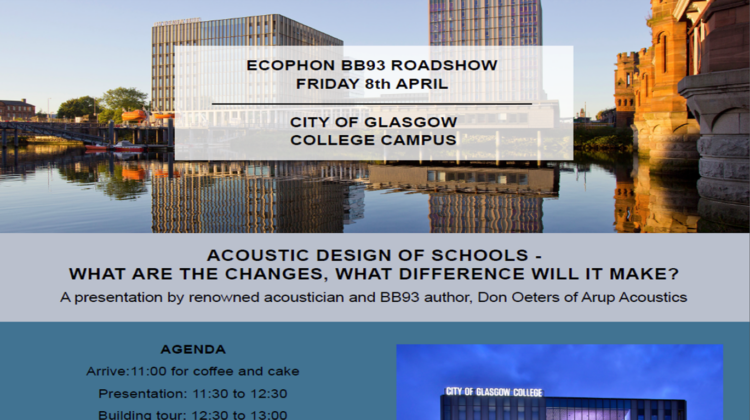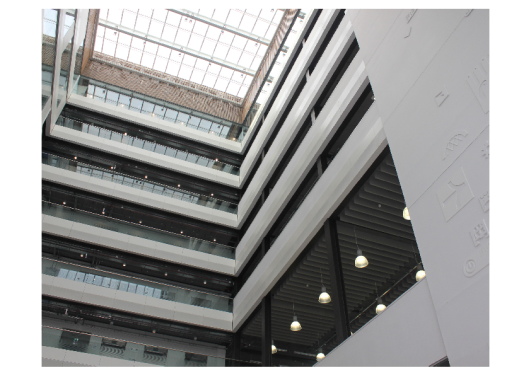
In April this year, Shane Cryer – Educational Environments Concept Developer continued Ecophon’s BB93 roadshows with a case study visit to the newly opened City of Glasgow College Riverside Campus, to highlight the importance of acoustics in education.
This £66m campus, accommodating 2000 students, is just part of the overall £228m scheme to replace 11 aging buildings and change the very skyline of Glasgow. The City Centre Campus, which will connect to Riverside, is due for completion in Aug 2016.
A large number of high profile architectural practises and contractors were in attendance, including: joint project architects Michael Laird and Reiach & Hall, as well as main contractor McAlpine. The guest speaker was Don Oeters of Arup Acoustics, who co-authored the updated BB93: Acoustic Design of Schools, published by EFA in February 2015. He was joined by Luke Robertson, project acoustician from Arup’s Glasgow office.
Baffles needn’t be baffling
“The accurate predicted reverberation time of an extremely large number of varying teaching spaces was crucial in achieving a successful design. Arup Acoustics used the following steps to achieve this: the results of multiple calculation methods were compared to improve certainty; absorption coefficient data from Arup’s extensive library of both laboratory and in-situ commissioning measurements, along with the manufacturers laboratory data, was drawn upon; optimal positioning of the acoustic baffles, rafts and wall panels was developed with the Architect to ensure maximum absorption efficiency and early testing of mock-up rooms was organised to verify the predictions. The result was close correlation between predicted and measured results, a successful design and a happy Contractor and Client,” says Luke.
Highly absorbing acoustic baffles in slate grey to underside of concrete soffit were specifies and some of the more acoustically challenging areas.
Although BB93 is not mandatory in Scotland, as it is in England and Wales, it was utilised within the brief. Don Oeters explains the new changes, some of which he wrote, and which were adopted for the design.
“Criteria for sound insulation, internal ambient noise and reverberation control are similar to BB93 (2003). BB93 (2015) addresses some compliance issues including cross-ventilation from classrooms to circulation and specification of sound absorbing finishes to sports halls and gyms. There are now defined criteria for ‘Alternative Performance Standards’ and refurbished rooms. Other changes include the introduction of recommended noise limits from equipment such as projectors or fume cupboards, which are described in more detail in the Association of Noise Consultants online publication Acoustics of Schools: a design guide. Also, new standards, in line with the Equalities Act, now take into account students with a more broadly defined range of language and communication difficulties.”
Thousands of acoustic baffles and rafts were utilised as part of the acoustic and thermal strategy, and were manufactured in “slate grey” to complement the exposed concrete soffit.
This stunning campus has already picked up several awards including the RICS Award: Design through Innovation. The latest win came on 25th May when its architects lifted the Scottish Design Awards for Best Public Building and Architectural Grand Prix.
In addition to this event, over the past six months there have been a series of these BB93 Roadshows arranged by Shane Cryer which have been interspersed with various BB93 authors who were part of the BB93 review panel and other acoustic consultants. The BB93 authors and other influential acousticians presented the updated acoustic design standard and how to apply it in practice. Many roadshows have taken place so far, throughout the UK and also Ireland due to the interest.
For more info contact Shane Cryer, Concept Developer for Educational Environments in the UK and Ireland.


